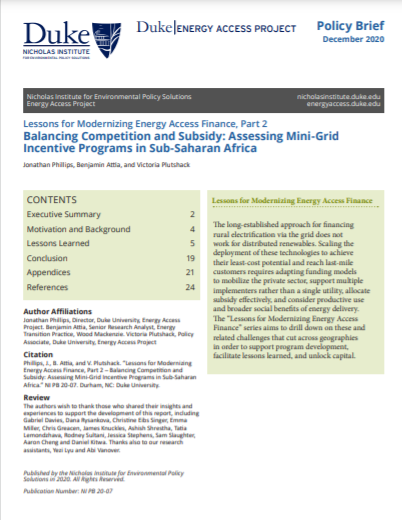Lessons for Modernizing Energy Access Finance

A modern energy system requires modern energy finance. This on-going series explores the ways in which we can learn from how energy access has been financed in the past to build a better, more equitable future.
Part One: Public Financing for Rural Electrification
What the Electrification Experiences of Seven Countries Tell Us about the Future of Connection Costs, Subsidies, and Integrated Planning
Jonathan Phillips, Victoria Plutshack, Seth Yeazel
Countries facing electricity access challenges today have more options and potential electrification pathways than ever before. However, the initial cost of connecting new rural customers remains an expensive proposition, and public financing that addresses the affordability issue will be required for most countries to achieve universal access, just as it always has. This brief explores the successful rural electrification experiences of seven case countries—Brazil, Chile, Laos, Peru, South Africa, Thailand, and Tunisia—looking specifically at the cost of connections and how subsidies and public financing were deployed to address the affordability challenge and facilitate energy access.
An off-grid energy future requires learning from the past
Jonathan Phillips, Gabriel Davies, Victoria Plutshack
The more things change, the more they stay the same. The Energy Access Project, in collaboration with the Energy Access team at CrossBoundary Group, looked at the experiences of seven countries that have made great strides in bringing electricity to their rural populations: Brazil, Chile, Laos, Peru, South Africa, Thailand, and Tunisia. Despite widely different circumstances and initial electrification rates, there are important similarities. Two stood out: the costs of such programs and the role of subsidies in facilitating last-mile connections.
Part Two: Mini-Grid Incentive Programs
Balancing Competition and Subsidy: Assessing Mini-Grid Incentive Programs in sub-Saharan Africa
Jonathan Phillips, Benjamin Attia, Victoria Plutshack
Falling costs and improved technology have made mini-grids a high-impact electrification solution for up to 490 million people currently without access. This brief reviews 20 mini-grid incentive programs in sub-Saharan Africa that primarily use auctions or results-based financing to incentivize developers. While there is extensive experimentation going on, and it is too early to draw hard conclusions around impact and effectiveness, this report offers reflections on some clear trends that are starting to emerge.
Lessons from the proliferating mini-grid incentive programs in Africa
Jonathan Phillips, Benjamin Attia, Victoria Plutshack
A few years ago, least-cost electrification models began pointing to an exciting possibility: solar and solar-diesel hybrid mini-grids could be the cheapest way to deliver reliable, on-demand electricity for hundreds of millions of people without power. We studied 20 mini-grid programs in sub-Saharan Africa, 17 of which are currently being implemented, in order to pull out some initial lessons.
Balancing Competition and Subsidy: Mini-grid Incentive Programs in Africa
What can we learn from countries trying to scale mini-grid deployment? In this webinar, hear early lessons from Africa in the latest report from the Energy Access Project at Duke, “Balancing Competition and Subsidy: Mini-grid Incentive Programs in Africa.” EAP’s Jonathan Phillips and Victoria Plutshack led the discussion with a host of experts in the field.




